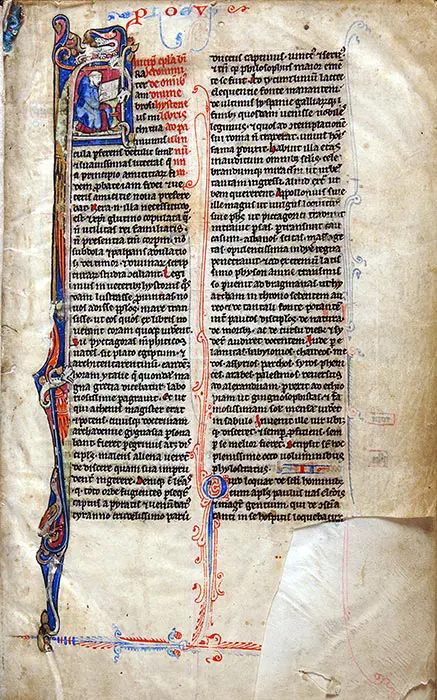Case 9
- St. Jerome
![Biblia cum tabula nuper impressa [et] cum summariis nouiter editis. Venice: Simon Bevilaqua, 8 May 1498. RBP Bible Latin 1498](https://www.reedgallery.co.nz/__data/assets/image/0017/221705/signs-case9-1a.webp)
Biblia cum tabula nuper impressa [et] cum summariis nouiter editis. Venice: Simon Bevilaqua, 8 May 1498. RBP Bible Latin 1498
The figure of St. Jerome at his desk is one of the most familiar images in biblical and iconographic studies. Jerome, one of the early Church Fathers and the patron saint of scholars, librarians and booksellers (among others), was also the author of the Latin Vulgate translation of the Bible, which became the accepted translation of the Roman Catholic Church.
The animal above the central panel is a lion, one of the emblems of St. Jerome.
![Biblia cum tabula nuper impressa [et] cum summariis nouiter editis. Venice: Simon Bevilaqua, 8 May 1498. RBP Bible Latin 1498](https://www.reedgallery.co.nz/__data/assets/image/0017/221705/signs-case9-1a.webp)
Biblia cum tabula nuper impressa [et] cum summariis nouiter editis. Venice: Simon Bevilaqua, 8 May 1498. RBP Bible Latin 1498
Open image in new window
![Biblia cum tabula nuper impressa [et] cum summariis nouiter editis. Venice: Simon Bevilaqua, 8 May 1498. RBP Bible Latin 1498](https://www.reedgallery.co.nz/__data/assets/image/0006/221577/signs-case9-2.webp)
Biblia cum tabula nuper impressa [et] cum summariis nouiter editis. Venice: Simon Bevilaqua, 8 May 1498. RBP Bible Latin 1498
Close-up of the historiated initial ‘P’ with St. Jerome, which opens his prologue to the Bible.
![Biblia cum tabula nuper impressa [et] cum summariis nouiter editis. Venice: Simon Bevilaqua, 8 May 1498. RBP Bible Latin 1498](https://www.reedgallery.co.nz/__data/assets/image/0006/221577/signs-case9-2.webp)
Biblia cum tabula nuper impressa [et] cum summariis nouiter editis. Venice: Simon Bevilaqua, 8 May 1498. RBP Bible Latin 1498
Open image in new window

Bible, in Latin. Northern France (perhaps Paris), thirteenth century. Reed MS4b
This image depicts the hermetical St. Jerome as an old man in the wilderness rather than as a scholar in his study. He is often shown in this setting beating himself with a rock in penance before the Cross, but here he is instead hard at work revising the Bible.
St. Jerome’s other emblems are the cardinal’s hat (at lower right) and the lion. The animal refers to the allegorical story of how the beast, suffering from a thorn in its paw, had frightened the other monks (visible at a safe distance) but not Jerome. Instead, he removed the thorn and cleaned the wound. As a result, the grateful lion became St. Jerome’s companion and remained in the monastery. Thorns were symbolic of sin as in the Crown of Thorns, and their removal a sign of baptism or banishing the beast in humanity.
![Biblia cum tabula nuper impressa [et] cum summariis nouiter editis. Venice: Simon Bevilaqua, 8 May 1498. RBP Bible Latin 1498](https://www.reedgallery.co.nz/__data/assets/image/0017/221705/signs-case9-1a.webp)
![Biblia cum tabula nuper impressa [et] cum summariis nouiter editis. Venice: Simon Bevilaqua, 8 May 1498. RBP Bible Latin 1498](https://www.reedgallery.co.nz/__data/assets/image/0006/221577/signs-case9-2.webp)
